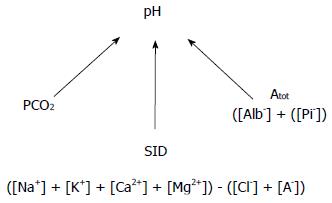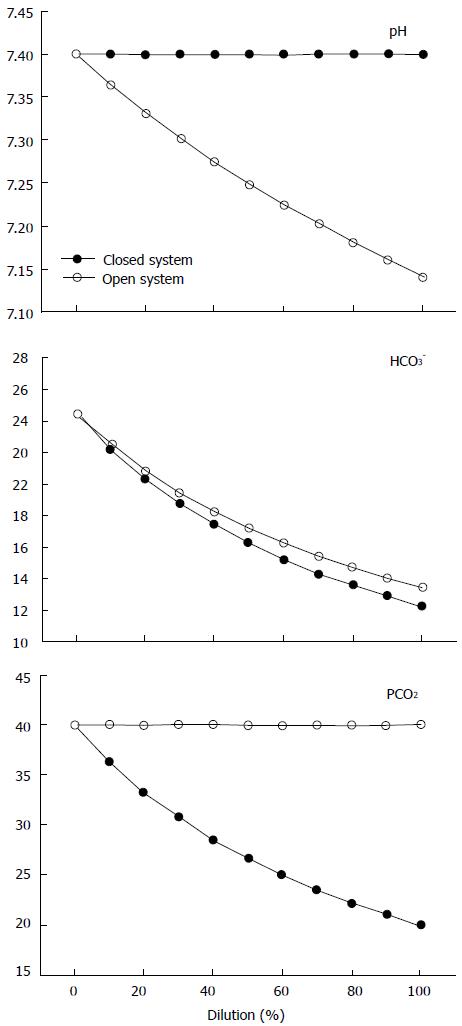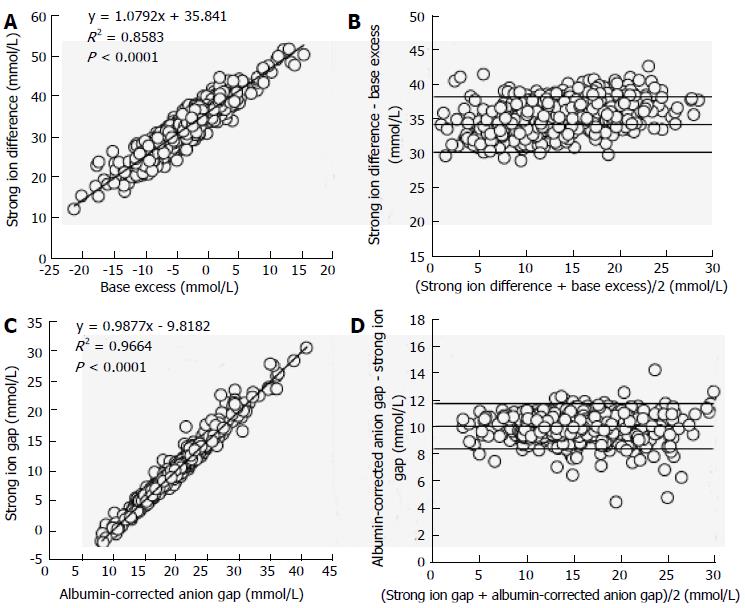Copyright
©The Author(s) 2015.
World J Crit Care Med. Feb 4, 2015; 4(1): 62-70
Published online Feb 4, 2015. doi: 10.5492/wjccm.v4.i1.62
Published online Feb 4, 2015. doi: 10.5492/wjccm.v4.i1.62
Figure 1 Independent determinants of pH according to the Stewart approach.
Figure 2 Behavior of pH (top), HCO3- (middle) and PCO2 (bottom) in a closed system (black dots) and in an open system with a PCO2 of 40 mmHg (withe dots), during stepwise dilution with 0.
9% NaCl, as modified from Gattinoni et al[32].
Figure 3 Regression and Bland and Altman analysis between metabolic parameters of different approaches in seven normal volunteers.
A: Lineal regression between base excess and strong ion difference; B: Agreement between base excess and strong ion difference; C: Lineal regression between albumin-corrected anion gap and strong ion gap; D: Agreement between albumin-corrected anion gap and strong ion gap; Panel B and D display the relationship between the mean value and the difference of both measurements. The lines indicate the mean difference between both parameters (bias) ± 2 SD (95% limits of agreement). Modified from Dubin et al[37].
Figure 4 Regression and Bland and Altman analysis between metabolic parameters of different approaches in 935 critically ill patients.
A: Lineal regression between base excess and strong ion difference; B: Agreement between base excess and strong ion difference; C: Lineal regression between albumin-corrected anion gap and strong ion gap; D: Agreement between albumin-corrected anion gap and strong ion gap. Panel B and D display the relationship between the mean value and the difference between both measurements. The lines indicate the mean difference between both parameters (bias) ± 2 SD (95% limits of agreement). Modified from Dubin et al[37].
Figure 5 Arterial pH, and bicarbonate levels in patients with severe hyperlactatemia.
Values for (A) arterial pH, (B) PCO2, and (C) bicarbonate ([HCO3-]) in patients with severe hyperlactatemia, with normal or low base excess. aP < 0.05 vs the other group.
Figure 6 Strong-ion difference, sodium-corrected chloride, albumin, and nonvolatile weak acid levels in severe hyperlactatemia patients.
Values for (A) the effective strong-ion difference (SIDeffective), (B) sodium-corrected chloride levels (Cl-corrected), (C) the albumin concentration, and (D) nonvolatile weak acid (Atot) levels in patients with severe hyperlactatemia, with normal or low base excess. aP < 0.05 vs the other group. SIDeffective: Effective strong-ion difference.
- Citation: Masevicius FD, Dubin A. Has Stewart approach improved our ability to diagnose acid-base disorders in critically ill patients? World J Crit Care Med 2015; 4(1): 62-70
- URL: https://www.wjgnet.com/2220-3141/full/v4/i1/62.htm
- DOI: https://dx.doi.org/10.5492/wjccm.v4.i1.62














